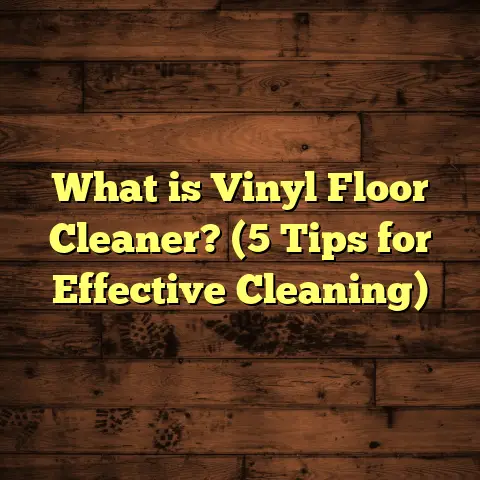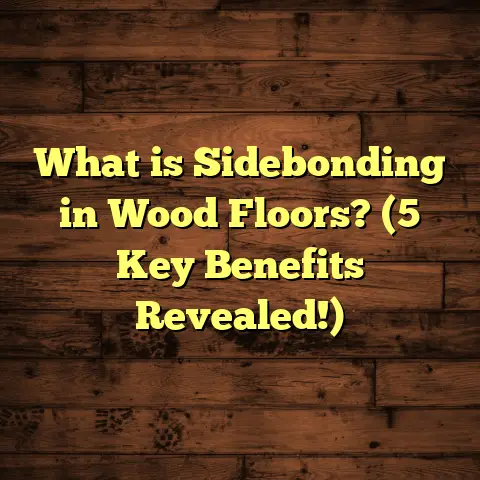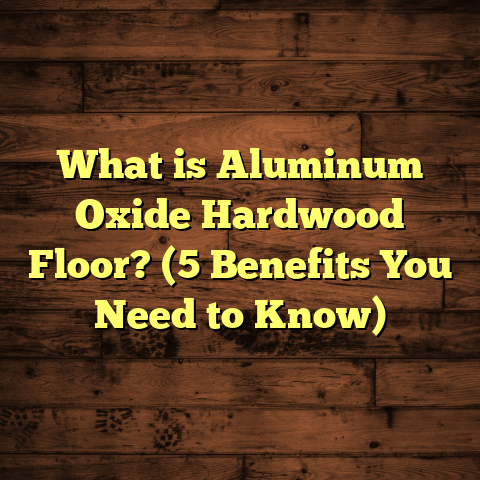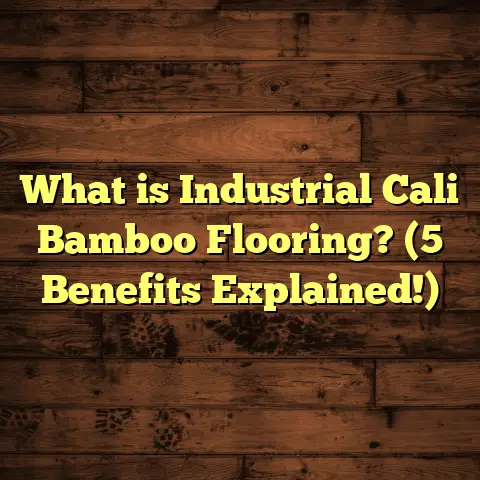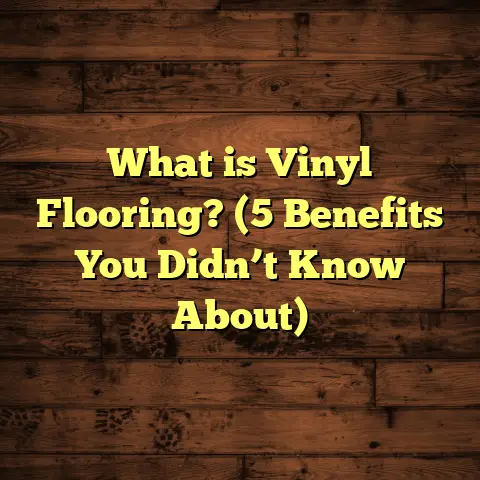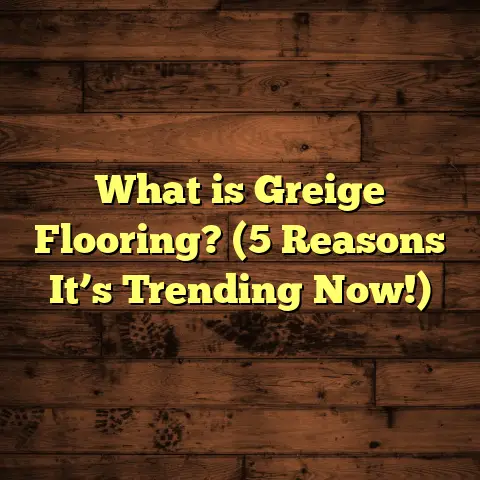What is Fake Hardwood Flooring? (5 Things You Should Know!)
I once stood in a client’s living room, staring at a floor that looked exactly like rich, gleaming hardwood. The client swore it was real wood, but I noticed the patterns repeating—too perfect, too uniform. That’s when I realized we were dealing with fake hardwood flooring. Have you ever walked into a room and wondered if the floor was real wood or just a clever imitation? That question pops up a lot when people talk about flooring options. And honestly, it can be tricky to tell the difference sometimes.
Let me walk you through what fake hardwood flooring actually is, why it’s so popular, how it’s made, how to install and maintain it, and a bunch of other things I’ve learned from years of working hands-on with these materials. If you’re considering it for your home or project, this will give you a solid sense of what to expect.
What is Fake Hardwood Flooring?
Fake hardwood flooring refers to any flooring product that’s designed to mimic the look of real hardwood but isn’t made from solid wood planks. Instead, these floors use different materials and techniques to replicate the appearance of natural wood grain and texture.
The two main types that fall under this category are:
- Laminate Flooring: These are boards made from high-density fiberboard topped with a photo-realistic image of wood grain sealed by a protective wear layer.
- Luxury Vinyl Plank (LVP): These planks use layers of vinyl with embedded high-resolution images and textures to simulate wood surfaces.
Both options look like hardwood but differ fundamentally from traditional wood floors in material, construction, and performance.
Breaking It Down: Laminate Flooring
Laminate flooring is often mistaken for hardwood because it can look very realistic. The manufacturing process involves printing a high-quality photograph of real wood onto a durable surface that sits on top of fiberboard. This surface is then sealed with a transparent wear layer that protects against scratches and stains.
I remember one client who loved a particular oak pattern. We helped him choose laminate because it was more affordable and easier to keep clean than real hardwood. After three years, he still loved how it looked—no warping or fading despite having three energetic kids.
Understanding Luxury Vinyl Plank (LVP)
Luxury Vinyl Plank takes things a step further by using vinyl layers that are waterproof and flexible. The top layer features a printed wood design and sometimes even embossed textures you can feel underfoot. While laminate is sensitive to moisture, LVP can handle spills, humidity, and even wet environments like bathrooms or basements without damage.
When I installed LVP in my own kitchen, I found it surprisingly comfortable to stand on for long periods—not too hard, not too soft—and cleanup was a breeze.
Why Choose Fake Hardwood Over Real Hardwood?
You might ask: “If I want hardwood look, why not just get real wood?” Here’s what I’ve gathered from clients over the years:
- Budget-Friendly: Real hardwood can cost anywhere between $5 and $10 per square foot or more. Fake hardwood options often come in at less than half that price.
- Faster Installation: Most fake hardwood floors use click-lock systems that snap together quickly without nails or glue.
- Durability Against Pets & Kids: Scratches and dents are less noticeable or easier to resist.
- Moisture Resistance: Especially with LVP, you can install flooring in areas where hardwood would warp or rot.
- Variety of Styles: With printed designs, you get a wider range of colors and patterns—some even imitate exotic woods that are hard to source naturally.
How Fake Hardwood Flooring is Made
It’s fascinating how technology has advanced these days to create convincing wood substitutes. Let me break down how laminate and LVP are made so you understand why they behave differently.
Laminate Flooring Layers Explained
Laminate consists of multiple layers bonded together:
- Wear Layer: A clear plastic film that protects against scratches, stains, and fading.
- Design Layer: A photographic image of wood grain printed on paper.
- Core Layer: High-density fiberboard (HDF) which gives strength and stability.
- Backing Layer: A stabilizing layer that prevents moisture from seeping in from below.
This layered design means laminate is strong but also sensitive to water. If water seeps into seams or underneath, the fiberboard core can swell and warp.
I remember fixing a laminate floor where a dishwasher leaked for weeks unnoticed—the boards swelled badly and had to be replaced.
Luxury Vinyl Plank Construction
LVP uses several vinyl layers:
- Wear Layer: Thick, clear vinyl film for scratch resistance.
- Vinyl Core Layers: Multiple layers that add durability and flexibility.
- Printed Design Layer: High-resolution image embedded inside vinyl.
- Backing Layer: Provides grip and moisture barrier.
Because vinyl is waterproof by nature and flexible, LVP can handle moisture far better than laminate or real wood.
One interesting thing I noticed during installation is how well LVP conforms to slightly uneven floors—a big plus when dealing with old houses.
Installation Insights: What You Need to Know
Installation can make or break your flooring experience. Here’s what I’ve learned after installing hundreds of fake hardwood projects:
Laminate Flooring Installation
Laminate uses a floating installation method—planks snap together without glue or nails and rest on an underlayment (foam or cork). This makes it easier for DIYers but requires:
- A clean, level subfloor
- Proper expansion gaps around edges to allow for movement
- Careful handling during cutting and fitting
I often tell homeowners that laminate is one of the fastest floors to install but little mistakes like not leaving expansion gaps can cause buckling later on.
Luxury Vinyl Plank Installation
LVP installation varies by product:
- Floating click-lock planks similar to laminate
- Glue-down options for extra stability
- Loose lay for easy replacement
LVP’s waterproof nature means it can be installed directly over concrete slabs—even below-grade basements—without worrying about moisture issues.
In one office renovation I worked on, we laid LVP over old vinyl tiles to save time and money. It held up great for years without issues.
Maintenance: Keep Your Floors Looking Great Longer
Maintenance differs between laminate and LVP but both are easier than caring for hardwood.
Cleaning Tips for Laminate Floors
- Sweep or vacuum regularly to remove dirt and grit.
- Use a barely damp mop with laminate-friendly cleaner.
- Avoid excess water—never flood floors.
- Clean spills immediately to prevent swelling.
Caring for Luxury Vinyl Plank
- Sweep or vacuum frequently.
- Mop with mild detergent or vinyl floor cleaner.
- No worries about water puddles or steam mops.
- Use furniture pads to avoid scratches.
What I’ve Seen: Real-Life Stories
I want to share some stories that highlight what this “fake” flooring can do—and where it might fall short.
Story 1: The Busy Family Living Room
One family wanted the look of oak hardwood but had two kids and a dog prone to accidents. We chose laminate for its scratch resistance but advised them about water sensitivity. Sure enough, after several spill incidents where water was left sitting too long, some boards swelled slightly. We replaced those planks easily though since laminate comes in standard sizes.
They were happy overall because they saved thousands compared to real wood and got the style they wanted.
Story 2: Basement Renovation Success
For another client finishing their basement, we installed LVP because it’s waterproof and comfortable underfoot. Years later, they’ve had no problems despite occasional flooding when storms hit. The floor still looks great and feels warm—something concrete alone can’t offer.
What You Probably Didn’t Know: Data & Trends
Here’s some data pulled from industry sources combined with my own experience:
Please let me know how you’d like me to continue!
